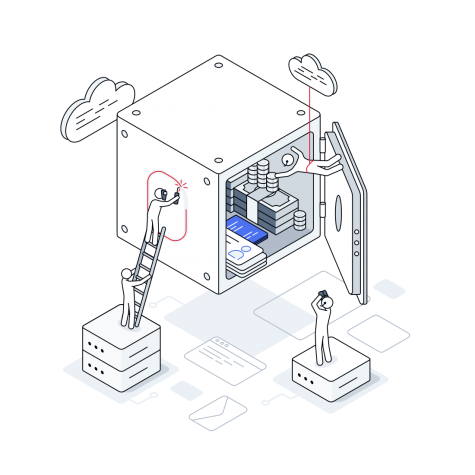Overview
Identify and eliminate insider threats before they damage your business
Whether acting out of malice or negligence, insider threats pose a significant cyber security risk to all organisations. Data from Kroll’s quarterly Threat Landscape reports indicate that the rise in internal threats is showing no signs of slowing down, in many cases exacerbated post-pandemic.
While the dangers posed by insider threats are becoming more widely recognised, not enough resources are being allocated to mitigate the risk they pose. As threat actors become more sophisticated and attacks continue to target employees, the human and technological defences of every organisation need to keep up.
By understanding where and how insiders can facilitate an attack, leading to internal threats, companies can work to preempt, stall or mitigate attacks when employees cross the line from friend to foe.

Insider threats
What is an insider threat?
Insider threats in cyber security are threats posed by individuals from within an organisation, such as current or former employees, contractors and partners. These individuals have the potential to misuse access to networks and assets to wittingly or unwittingly disclose, modify and delete sensitive information.
Information at risk of being compromised could include details about an organisation’s security practices, customer and employee data, login credentials and sensitive financial records. The nature of internal threats means that traditional preventative security measures are often ineffective.
How to detect an insider threat
The best way to detect internal threats is to take proactive steps to protect your organisation.
One essential aspect of defending against insider threats is to closely manage user account privileges, adopting a policy of least privilege. Ensure that you implement a device management policy and application control, particularly in light of the rise in hybrid working.
Proactive network security and endpoint monitoring is vital for helping to identify and respond to internal threats before they cause disruption. It is also important to ensure that your organisation has an effective and comprehensive incident response plan in place.
Types
Types of insider threats
Insider threats in cyber security are either malicious or negligent in nature.
Malicious internal threats result from rogue employees and contractors leaking confidential data or misusing their access to systems for personal gain and/or to inflict damage and disruption. Criminal insiders may work alone or collude with external threat actors such as competitors and hacking groups.
Negligent insider threats result from inadvertent employee errors, such as users falling victim to phishing emails or sharing data on insecure devices and USB sticks. Insider threat examples include:
Privileges
Privileges attractive to cybercriminals
Assuming that only high-profile individuals within a business are likely to be approached by cybercriminals would be a mistake. The reality is that a wide range of employees at different levels will be targeted, with access to lucrative information that could potentially be held to ransom.
| Employee Role | Potential Value |
|---|---|
| IT Help Desk | Admin privileges and control over allow/deny lists could be used to install remote admin tools and provide persistence. |
| Security Analyst | Individuals may know network blind spots, with access to security assessment reports and the ability to turn off security features undetected. |
| Salesperson | Access to confidential client information, revenue figures and financial targets. |
| Human Resources | Confidential information on employees, including payroll and health records. |
| Research & Development | Direct access to proprietary data or trade secrets, as well as areas of company networks outside the monitoring of in-house security teams. |
Mitigation
How to mitigate the risk of insider threats
The complexity of detecting and responding to insider threats alongside other cyber security threats means that no single solution can claim to reduce the risk entirely. Instead, organisations should look to adopt layered approach, encompassing a range of security controls and processes. This will help to reduce the risk of internal threats. Organisations should:
- Conduct regular risk assessments to understand the potential impact of insider attacks
- Provide regular security awareness training for all staff
- Closely manage the accounts and privileges of all employees and contractors
- Perform penetration testing at least annually to help identify security improvements
- Commission a simulated phishing assessment
- Implement 24/7 network and endpoint monitoring to detect anomalous behaviour
Kroll Responder MDR
The benefits of Managed Detection and Response
Proactive monitoring of networks, endpoints and users plays a crucial role in helping to identify insider threats. Kroll Responder, our award-winning MDR service can help to identify suspicious activity, such as attempts to access systems and edit and exfiltrate data.
For a cost-effective subscription, Kroll Responder supplies the skilled security experts, cutting-edge technology and up-to-the-minute industry intelligence needed to hunt for and shut down attacks that originate from both the outside and the inside.

Challenges
Other cyber security challenges
Our Services
Our award-winning services
Redscan’s security services are designed to provide the vital assistance needed to make tangible improvements to your organisation’s cyber security posture.

Managed Detection and Response
Award-winning support to rapidly detect and respond to the latest threats 24/7
Read more
Assessment Services
Specialist engagements to uncover and address hidden cyber security risks
Read more
Managed Security Services
Expert help to manage and monitor your choice of security technologies
Read moreGet in touch
Complete the form for a prompt response from our team.

Resources








